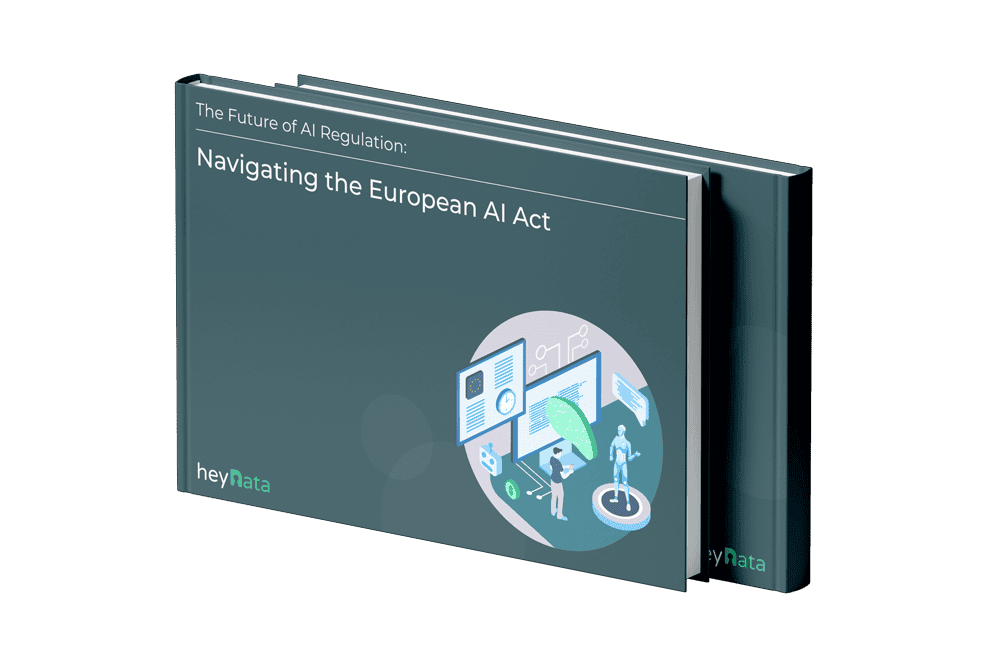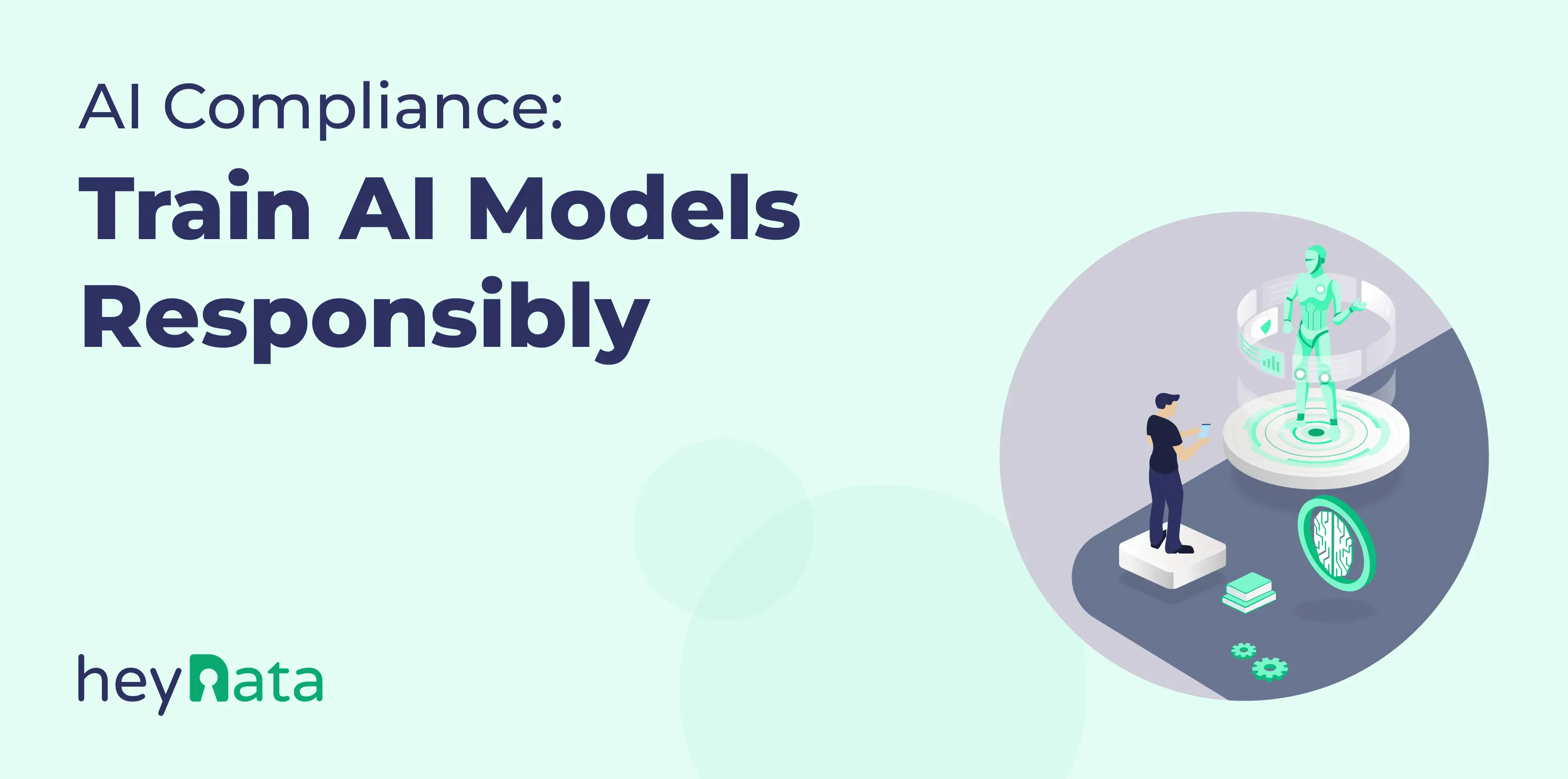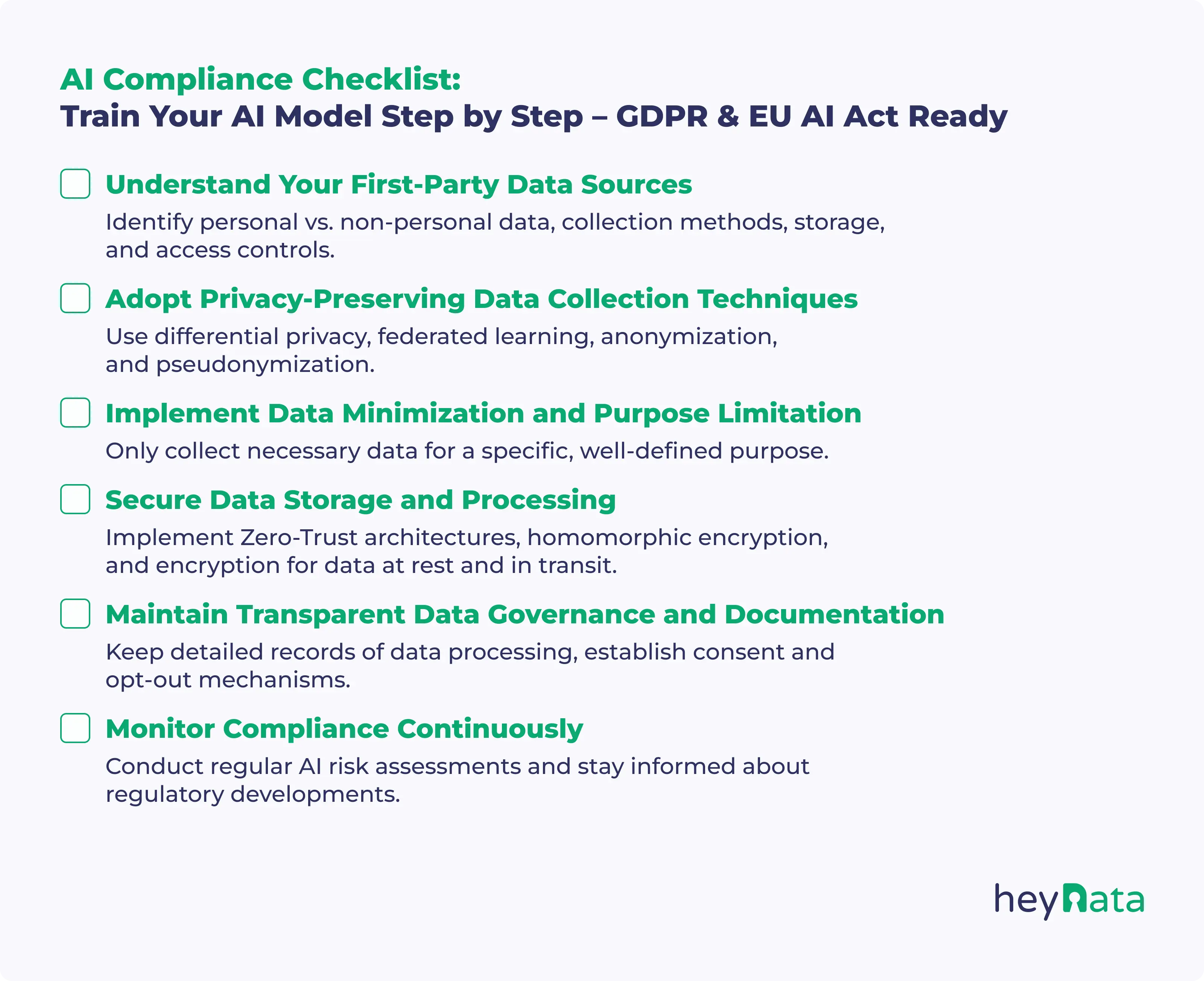
Everything Your Company Needs to Know About the AI Act!
Get our free whitepaper and learn how to easily and successfully comply with the EU AI Act requirements.

How to Train Your AI Model While Staying Compliant

'%3e%3cpath%20d='M26.6667%2020.022L30%2023.3553V26.6886H21.6667V36.6886L20%2038.3553L18.3333%2036.6886V26.6886H10V23.3553L13.3333%2020.022V8.35531H11.6667V5.02197H28.3333V8.35531H26.6667V20.022Z'%20fill='%230AA971'/%3e%3c/g%3e%3c/svg%3e) Key Findings
Key Findings
- AI compliance ensures your models meet GDPR and EU AI Act requirements.
- Non-compliance risks include heavy fines and reputational damage.
- First-party data is crucial for accuracy and privacy-friendly AI training.
- The EU AI Act classifies AI systems by risk, imposing stricter rules on high-risk applications.
- Use privacy-enhancing technologies and maintain transparent documentation.
AI models trained on first-party data are becoming increasingly important, leading to improvements in personalization, automation, and decision-making. As businesses increasingly rely on AI models trained on first-party data, ensuring AI compliance has become a critical priority.
Data privacy regulations such as the General Data Protection Regulation (GDPR) and the European Union’s AI Act (EU AI Act) impose strict requirements on AI development, data collection, and model training.
Failing to comply with these regulations can lead to significant financial penalties, reputational damage, and loss of consumer trust.
In this article, we'll explore the importance of first-party data in AI training, key legal considerations, and best practices for ensuring compliance with GDPR and the EU AI Act.
Table of Contents:
1. Why First-Party Data is Key to AI Training
First-party data is information collected directly from customers, users, or business interactions. Unlike third-party data, which is aggregated from external sources, first-party data brings several benefits:
- Higher Accuracy – While third-party sources may contain outdated or irrelevant information, first-party data is sourced directly from customers, ensuring its reliability for AI training.
- Stronger Compliance – Businesses have greater control over data collection, storage, and processing, reducing regulatory risks. This direct oversight allows organizations to implement strong data governance frameworks and maintain clear audit trails for compliance.
- Enhanced Privacy Control – By sourcing data directly, organizations can implement strong security measures and transparency protocols tailored to their needs.
Businesses use first-party data for AI training in many areas, taking advantage of its accuracy and compliance benefits.
For example, AI models can analyze first-party data to predict customer behavior and improve engagement. Similarly, businesses use AI to tailor recommendations based on first-party behavioral data. Or, in fraud detection, AI systems trained on transactional data can identify suspicious patterns.
2. GDPR Compliance: Key Legal Considerations for Using First-Party Data in AI Training
Under GDPR, businesses must establish a lawful basis for processing personal data for AI training.
This can include:
- Legitimate Interest – AI training that benefits both the business and the consumer while minimizing privacy risks.
- User Consent – Explicit opt-in from users for data processing.
- Contractual Necessity – AI-driven services that require data processing to fulfill contractual obligations.
Transparency is another cornerstone of GDPR compliance requirements. Businesses must inform users about how their first-party data is utilized in AI training. This includes clearly stating the purpose of data collection, detailing how long the data will be retained, as well as explaining any potential risks associated with data usage.
Understanding user rights is also essential. Data subjects have several rights related to their personal information, including the right to access their personal data held by an organization, the right to rectify inaccurate or incomplete personal information, as well as the right to opt out of data processing under certain circumstances, particularly when it involves direct marketing or profiling.
In addition, organizations must adhere to GDPR principles such as data minimization, which mandates organizations to only collect and process the minimum necessary amount of personal data for AI training purposes. Purpose limitation is another GDPR principle that ensures that collected data is used strictly for its intended purpose and not processed further in ways incompatible with that purpose.
Lastly, article 22 of the GDPR restricts fully automated decisions (e.g., AI approving or rejecting loan applications) unless there is explicit user consent, there are legal protections such as human oversight, or the decision is necessary for a contract.
These obligations guide organizations in responsibly handling first-party data while developing AI models.
3. The EU AI Act's Impact on Using First-Party Data in AI Model Training
The EU AI Act introduces strict requirements for AI models trained on first-party data. The act introduces a risk-based approach to AI regulation, categorizing AI models into four levels of risk:
- Prohibited AI (e.g., social scoring) is outright banned.
- High-risk AI (e.g., financial risk assessments) requires strict documentation, human oversight, and transparency.
- Limited-Risk AI (e.g., chatbots) must disclose AI-generated content.
- Minimal-Risk AI (e.g., spam filters) faces no additional obligations.
For first-party data, businesses must implement robust data governance, bias mitigation, and risk assessments before using it to train AI.
They must also ensure ongoing monitoring to detect discriminatory outcomes. Unlike GDPR, which focuses on data privacy, the EU AI Act regulates AI’s fairness, accuracy, and ethical use.
Non-compliance can result in fines of up to €35 million or 7% of a company’s annual global revenue.
To stay compliant, businesses should integrate privacy-preserving techniques, strong documentation practices, and AI governance frameworks when training models on first-party data.
To learn more about EU AI Act compliance, read the 5 steps startups should take to become compliant or simply use our compliance solution.
To learn how to train your AI model on first-party data while staying compliant with both the GDPR and EU AI Act, read on.

Everything Your Company Needs to Know About the AI Act!
Get our free whitepaper and learn how to easily and successfully comply with the EU AI Act requirements.
4. How to Train AI Models on First-Party Data While Staying Compliant
4.1 Understand Your First-Party Data Sources
Before training AI models, you need to assess and categorize your first-party data to ensure compliance with GDPR and the EU AI Act. Understanding what type of data is collected helps determine legal processing bases and necessary safeguards.
To understand your first-party data, follow these steps:
- Identify Personal vs. Non-Personal Data - First, determine whether the data includes Personally Identifiable Information (PII) (e.g., names, emails) or sensitive data (e.g., health records, biometric data). Then, classify the data to understand its risk level under GDPR and the EU AI Act's risk-based framework.
- Determine Data Collection Methods - Next, ensure that data is collected with valid legal consent or under an appropriate legal basis (e.g., contractual necessity, legitimate interest).
- Assess Data Storage and Access Controls - Lastly, implement role-based access controls (RBAC) to limit who can access sensitive data and ensure data is stored in compliance with data residency laws (e.g., EU-based servers for GDPR compliance).
4.2 Adopt Privacy-Preserving Data Collection Techniques
Collecting raw user data increases compliance risks. Privacy-enhancing technologies (PETs) allow AI training while preserving user anonymity and security.
For instance, employing differential privacy introduces controlled noise into datasets, allowing the extraction of trends without compromising individual identities. For example, Apple uses differential privacy for AI-based user analytics without storing personal data.
Federated learning is another privacy-preserving technique, that, instead of centralizing raw data, it allows AI models to be trained across multiple decentralized devices. For example, Gboard - Google's keyboard app learns typing patterns without uploading private text inputs.
Where possible, leverage anonymization and pseudonymization to help protect personal data while allowing AI models to extract useful insights.
Use pseudonymization in cases where re-identification is required. This technique replaces personal identifiers with unique but reversible codes. For example, a financial AI model could replace customer names with unique IDs but retain a re-identification key.
In cases where no re-identification is needed, use anonymization. Anonymization removes all identifiers so data can never be linked back to an individual. For example, you can aggregate customer data for trend analysis without tracking individual users.
By adopting these privacy-preserving techniques, you can strike a balance between using valuable data for AI model training and safeguarding user privacy.
4.3 Implement Data Minimization and Purpose Limitation Principles
Under GDPR, businesses must ensure that they only collect and process the minimum amount of data necessary for a specific, well-defined purpose.
As such, avoid collecting data "just in case" - ensure to clearly document a business need for each dataset. For example, instead of collecting full customer profiles, an AI recommendation system might only need purchase history.
Similarly, AI training data should not be retained longer than necessary. Implement automated deletion policies to remove outdated datasets.
To further improve compliance with the data minimization principle, leverage Secure Multi-Party Computation (SMPC). This technique allows for collaborative data analysis without directly sharing the raw data. It enables different entities to jointly compute results while keeping their individual data private. For example, banks can collaborate on fraud detection AI models while keeping customer data private.
4.4 Secure Data Storage and Processing
AI training data must be stored and processed securely to prevent unauthorized access, breaches, or regulatory violations. As such, ensuring the security of first-party data during AI model training is crucial.
To secure your data storage:
- Implement Zero-Trust Security Architectures - This approach requires continuous authentication for users accessing AI training datasets. This minimizes the risk of unauthorized access by enforcing least privilege access.
- Adopt Homomorphic Encryption - This encryption protocol allows AI models to process encrypted data without decrypting it.
- Use Encryption for Data at Rest and in Transit - Secure data by applying encryption such as AES-256 for stored data and TLS 1.2+ encryption when transmitting data.
4.5 Maintain Transparent Data Governance and Documentation
AI governance ensures compliance with both GDPR documentation requirements and the EU AI Act's transparency obligations, under which organizations must maintain detailed records of data processing activities such as collection methods and storage practices.
For this reason, maintain meticulous records detailing the origins of all data utilized in AI training. This includes specifying how data is collected, processed, and stored, ensuring that all actions are traceable. Ensure AI model documentation includes dataset sources and preprocessing methods. You can generate automated compliance reports with AI compliance software such a heyData AI solution, which automates compliance documentation, reducing administrative burdens while ensuring your business is always audit-ready. The software generates and stores pre-filled compliance reports under EU AI Act requirements, which can be easily accessed for audits.
Additionally, establish comprehensive policies regarding user consent and opt-out mechanisms for AI training. Inform users about how their data will be used and provide straightforward options to revoke consent if desired. This approach safeguards user rights while facilitating responsible data usage.
4.6 Monitor Compliance Continuously
AI compliance is not a one-time effort - regulatory requirements evolve, and AI models must be regularly audited to ensure ongoing compliance.
Conduct regular AI risk assessments to identify potential bias, discrimination, or security risks in AI model outputs. This includes third-party audits on the AI decision-making process, identifying vulnerabilities, and implementing corrective measures to mitigate them. AI compliance solutions such heyDatas can automate the process by comparing your AI’s functions against regulatory definitions and, classify your system accordingly. With automated classification, you can save time and eliminate the guesswork of risk assessment.
It is essential to stay informed about regulatory developments, particularly GDPR and the EU AI Act, as changes may result in the need to adapt your AI model to maintain compliance with shifting legal landscapes, ensuring that privacy and ethical considerations are always prioritized. And since many businesses lack the in-house expertise in AI governance and regulatory compliance, our expert legal team at heyData is ready to deliver interactive training to your teams, while providing ongoing compliance support.

Conclusion
Balancing innovation in AI with data privacy and compliance is essential for sustainable growth. AI compliance is crucial for businesses looking to train AI models using first-party data while adhering to GDPR and the EU AI Act.
By implementing these best practices, you can train your AI model on first-party data while staying fully compliant with these regulations.
AI compliance software such as heyDatas plays a key role in automating risk assessments, generating audit reports, and ensuring regulatory adherence for businesses trying to train their AI models on first-party data while staying compliant.
As businesses continue to leverage AI and first-party data, maintaining a proactive approach to compliance will be key to achieving both innovation and regulatory adherence.
Frequently Asked Questions (FAQs)
Q1: What regulations govern AI compliance in the EU?
The GDPR and the EU AI Act are the main frameworks.
Q2: What are the penalties for non-compliance?
Fines can reach up to €40 million or 7% of global turnover, depending on the violation.
Q3: What defines a high-risk AI system?
Systems affecting safety, legal rights, or essential services (e.g., credit scoring).
Q4: How can I ensure AI transparency?
Use explainability tools and provide clear documentation of AI decisions.
Q5: What’s a good start to stay compliant?
Regularly update policies, document processes, and use automated compliance tools.
Important: The content of this article is for informational purposes only and does not constitute legal advice. The information provided here is no substitute for personalized legal advice from a data protection officer or an attorney. We do not guarantee that the information provided is up to date, complete, or accurate. Any actions taken on the basis of the information contained in this article are at your own risk. We recommend that you always consult a data protection officer or an attorney with any legal questions or problems.


